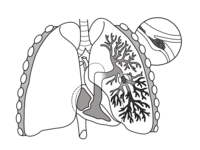
Photo from wikipedia
Abstract Background Invasive aspergillosis (IA) complicates the care of up to 13% of patients with varying forms of immune compromise. The accompanying morbidity and mortality associated with IA remains high.… Click to show full abstract
Abstract Background Invasive aspergillosis (IA) complicates the care of up to 13% of patients with varying forms of immune compromise. The accompanying morbidity and mortality associated with IA remains high. We sought to describe the epidemiology and outcomes for all hospitalizations associated with IA in the United States. Methods We analyzed the National Inpatient Sample (NIS) from the Agency for Healthcare Research and Quality (AHRQ) for 2010–2013. We identified subjects with high-risk conditions for IA (stem cell or solid organ transplant, critical illness, major surgery, mild-to-moderate immune compromise, severe immune compromise, and other [human immunodeficiency virus, pneumonia, chronic obstructive pulmonary disease]). IA was identified via ICD-9-CM codes 117.3, 117.9, and 484.6. We compared characteristics and outcomes between those with (IA) and without IA (non-IA). We calculated the IA-associated excess mortality, length of stay (LOS) and costs using propensity-score (PS) matching. Results Of the 66,634,683 discharges who met the study inclusion criteria, 154,888 (0.2%) had a diagnosis of IA. Patients with IA were more likely to be male (50.9% IA vs. 46.7% non-IA, P < 0.001), and African American (15.3% IA vs. 12.5% non-IA, P < 0.001). The most common high-risk condition among those not classified as IA was major surgery (50.1%). In the IA group critical illness was noted most frequently (41.0%). The burden of both chronic (median [interquartile range, IQR] number of Elixhauser comorbidities 3 [1, 5] non-IA vs. 4 [3, 6] IA, P < 0.001) and acute (median [IQR] number of procedures during the hospitalization 2 [1, 3] non-IA vs. 3 [1, 6] IA, P < 0.001) illnesses was higher in the IA group than the non-IA. After PS-matching, mortality in IA (14.1%) was 37% higher than in non-IA (10.3%, P < 0.001), translating to an odds ratio = 1.43; 95% CI (1.36, 1.51). IA was associated with 6.0 (95% CI 5.7, 6.4) excess days in the hospital and excess $15,542 (95% CI $13,869, $17,215) in costs/hospitalization. Conclusion Although rare even among high-risk groups, IA is associated with high hospital mortality, excess duration of hospitalization, and costs. Given nearly 40,000 annual IA admissions in the United States, we estimate that the aggregate IA-attributable excess costs may reach $600 million annually. Disclosures M. D. Zilberberg, Astellas: Grant Investigator, Research support. B. Nathanson, EviMed, LLC: Consultant, Consulting fee. R. Harrington, Astellas Pharma Global Development, Inc.: Employee, Salary. J. Spalding, Astellas Pharma Global Development, Inc.: Employee, Salary. A. F. Shorr, Astellas: Consultant and Speaker’s Bureau, Consulting fee, Research support and Speaker honorarium. Cidara: Consultant, Consulting fee. Merck: Consultant, Scientific Advisor and Speaker’s Bureau, Research support and Speaker honorarium
Journal Title: Open Forum Infectious Diseases
Year Published: 2017
Link to full text (if available)
Share on Social Media: Sign Up to like & get
recommendations!